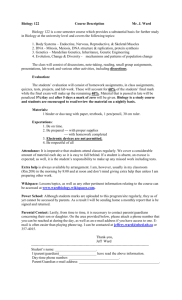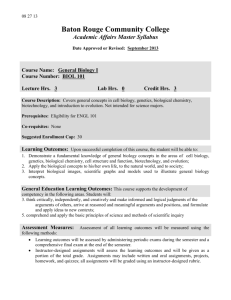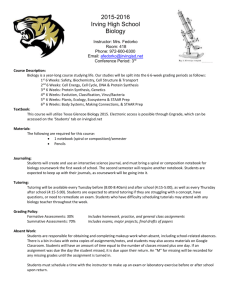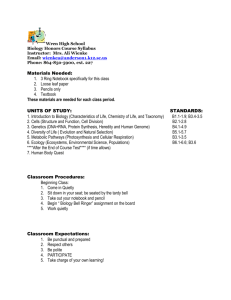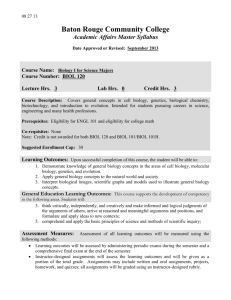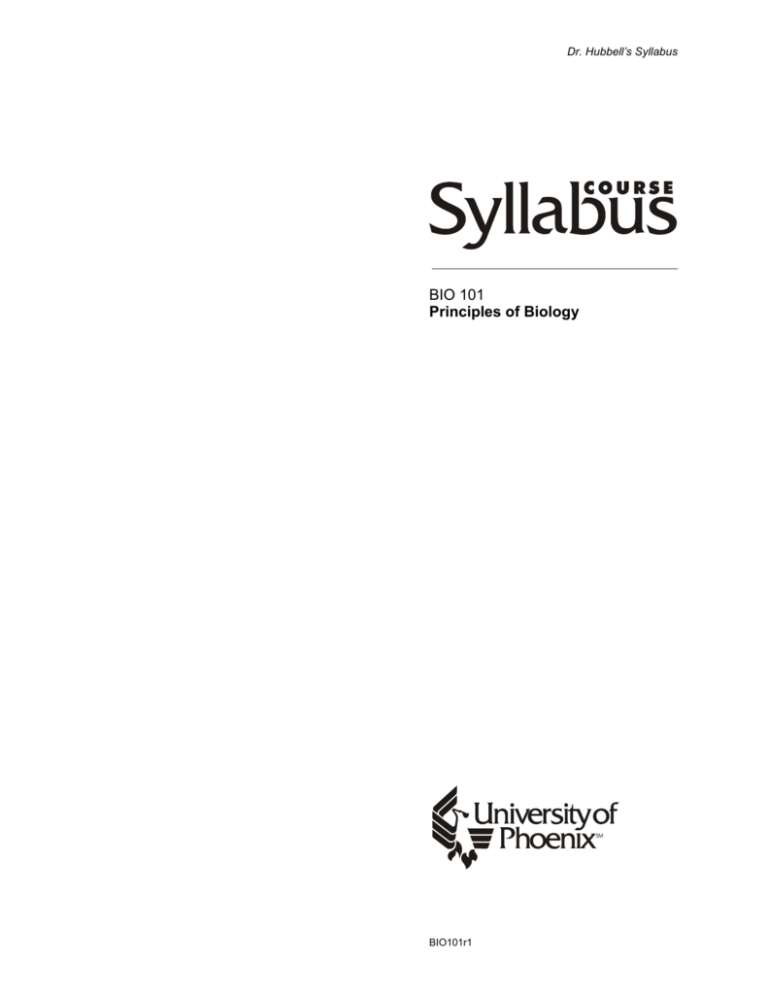
Dr. Hubbell’s Syllabus
BIO 101
Principles of Biology
BIO101r1
Dr. Hubbell’s Syllabus
BIO 101 Principles of
Biology
Program Council
The Academic Program Councils for each
college oversee the design and
development of all University of Phoenix
curricula. Council members include full-time
and practitioner faculty members who have
extensive experience in this discipline.
Teams of full-time and practitioner faculty
content experts are assembled under the
direction of these councils to create specific
courses within the academic program.
Copyright
Copyright 2007 by the University of Phoenix. All
rights reserved.
University of Phoenix® is a registered trademark of
Apollo Group, Inc. in the United States and/or other
countries.
Microsoft®, Windows®, and Windows NT® are
registered trademarks of Microsoft Corporation in the
United States and/or other countries. All other company
and product names are trademarks or registered
trademarks or their respective companies. Use of these
marks is not intended to imply endorsement,
sponsorship, or affiliation.
Edited in accordance with University of Phoenix®
editorial standards and practices.
BIO101r1
Dr. Hubbell’s Syllabus
BIO 101 Principles of Biology
Course Syllabus
Course Title:
BIO 101 Principles of Biology
Course Schedule:
06/22/2009 - 02/28/2009
Course Location/
Times/Newsgroup:
Baton Rouge Campus/ Monday/ 6-10pm
Required Text:
Campbell, Reece, & Simon (2007). Essential biology with
physiology. [UOP Special Edition Series]. San Francisco:
Pearson/Benjamin Cummings.
Note: All required text materials can be found on the BIO 101
course
pages. The
page can be accessed through the University of Phoenix
Student and Faculty Web site at https://mycampus.phoenix.edu/
Electronic Resources:
http://wps.aw.com/bc_campbell_essentials_3/47/12139/3107664.cw/ind
ex.html
Instructor’s Name:
Dr. John Hubbell
Telephone:
Work: 225-802-7455. Home: 225-769-0230
UOP E-mail Address:
uhigh@phoenix.edu
Alternative E-mail Address:
uhigh@mac.com
Availability:
Contact by phone or E-mail for appointment.
Welcome! to the golden age of biology. The largest group of scientists in history is moving ever closer to
understanding how a single cell becomes a plant or animal; how plants trap solar energy and store that
energy in food; how organisms form networks in biological communities such as forests and coral reefs; and
how the great diversity of life on Earth evolved from the first microbes. Welcome to the big adventure of the
twenty-first century! You will make discoveries that can help you live healthier and longer life. Together
we will explore our environment and think about our world in a new way.
Instructor Bio: Education: Masters of Science in Physics, Louisiana State U., & a Ph.D. in Horticulture
with a split minor in Experimental Statistics & Math. Experience: Worked as an IBM Systems Engineer
and in technology-transfer projects such as a NASA Information Project and an AgBiotech Consortium.
I conducted research at the J. Arthur Dwyer observatory (USA) & in the Far East at the Asian
Vegetable Research Center. Instruction: I taught at IBM, Louisiana State U., the U. of Illinois, and
Southern U.
Page 1
BIO101r1
Dr. Hubbell’s Syllabus
BIO 101 Principles of Biology
COURSE DESCRIPTION
This course is designed to introduce biology at an entry level by examining the hierarchy that
ranges from the fundamentals of cell biology to the physiology of organisms, and the interactions
among those organisms in their environment. The topics in this course include cell biology,
genetics, molecular biology, evolution, physiology, and ecology.
TOPICS AND OBJECTIVES
Cell Biology
Apply the scientific method to the creation of hypotheses and experiments.
Recognize the fundamental concepts of chemistry in biology.
Examine the energy metabolism of cells.
Compare and contrast structures and functions of different cell types.
Genetics and Molecular Biology
Recognize the structure and function of deoxyribonucleic acid (DNA) as the molecule of
inheritance.
Examine the foundations of genetics.
Explain meiosis as it relates to genetics.
Evolution and Diversity
Examine the mechanisms of evolution.
Describe the role of natural selection in the theory of evolution.
Recognize the importance of biodiversity.
Physiology
Identify the structure and function of the main organs in organisms.
Explain how organisms have evolved physiologically to become most suitable for their
environment.
Ecology
Examine ecology in terms of population growth and regulation through community
interactions.
Evaluate the effects of human activities on ecosystems and the biosphere.
Examine the flow of energy and materials through an ecosystem.
Page 2
BIO101r1
Dr. Hubbell’s Syllabus
BIO 101 Principles of Biology
Point Values for the Course Assignments
ASSIGNMENTS
DUE
POINTS
Individual (70%)
Class Participation
All
10
Assignments from the Readings
W1
11
Structure of DNA Paper
W3
14
Food Web Diagram
W5
10
Final Examination
W5
10
W2, W3, & W4
15
Evolution Connection Paper
W2
10
Natural Selection Paper
W4
10
Assignments from the Readings
W5
5
Assignments from the Readings Presentation*
W5
5
Quizes
Learning Team (30%)
*For Local-Campus students, these are oral presentations; for online and directed
study students, these are PowerPoint® presentations with notes.
Total
100
Course Changes
Please note that the instructor’s assignments may vary from the original syllabus you received
from the student web page. Assignments in this document take priority. While the reading
assignments and learning objectives remain the same, some of the assignments in this syllabus
have been customized for this particular section.
Policies and Procedures
Attendance and participation
You are expected to attend class for the entire class period. Average participation would be
graded as a C, which is worth 75% of 2 points. If you make a positive contribution to the quality of
the class, you will receive a B or A grade. If you arrive late or leave class early, points will be
deducted from your class participation grade. During in-class participation times, use of laptops
normally is not permitted.
Late assignments
Please be timely in submitting your assignments. I will not accept any assignments more than five
(5) days late. There will be a 10% per day deduction for late work. If you know you are going to
be away on a day an assignment is due, I will accept work early.
Submission of Assignments and Feedback
All written assignments must be submitted electronically to the online learning system (OLS). In
the subject line, enter your first and last names, SCI 256, the workshop number and the title of
the assignment. Team papers should include the names of each team member. Example: John
Page 3
BIO101r1
Dr. Hubbell’s Syllabus
BIO 101 Principles of Biology
Smith, Bio 101, Workshop 1, Scientific Method Paper. To access the OLS forums, click on the Go
to class link on your student website.
Take the OLS tutorial and familiarize yourself with this new process.
All assignments must be submitted to your individual (private) forum.
DO NOT post new threads, only replies to existing threads, which will originate with me.
Post questions or concerns for me in the main forum.
Learning teams will be assigned a forum in which they can work – exchange messages, post
written draft assignments, etc.
Learning team evaluations will be posted to your individual forum during week 5.
Incompletes
Incomplete grades and will be considered in extraordinary circumstances & only if (1.) you
are passing the course & (2.) you have requested an incomplete grade prior to the course
end date.
Academic Honesty
Academic honesty is highly valued at the University of Phoenix. You must always submit work
that represents your original words or ideas. If any words or ideas used in a class posting or
assignment submission do not represent your original words or ideas, you must cite all relevant
sources and make clear the extent to which such sources were used. Words or ideas that require
citation include all hard copy or electronic publications, whether copyrighted or not, and all verbal
or visual communication when the content of such communication clearly originates from an
identifiable source. Please see the University of Phoenix Catalog for more information about
academic honesty, including consequences of academic dishonesty.
Privacy and Confidentiality in the Online Classroom
One of the highlights of the University of Phoenix academic experience is that students can draw
on the wealth of examples from their organizations in class discussions and in their written work.
However, it is imperative that students do not share information that is confidential, privileged, or
proprietary in nature. Students must be mindful of any contracts they have agreed to with their
companies.
How Points and Percentages Equate to Grades
95-100
A
74-76
C
90-94
A-
70-73
C-
87-89
B+
67-69
D+
84-86
B
64-66
D
80-83
B-
60-63
D-
77-79
C+
0-59
F
Page 4
BIO101r1
Dr. Hubbell’s Syllabus
BIO 101 Principles of Biology
Week One
Cell Biology
Apply the scientific method to the creation of hypotheses and experiments.
Recognize the fundamental concepts of chemistry in biology.
Examine the energy metabolism of cells.
Compare and contrast structures and functions of different cell types.
ASSIGNMENTS
INDIVIDUAL
1. Read Chapters 1, 2, 3, 4, 5, and 7 in the text, Essential Biology with Physiology.
2. Essential Biology Website
a. Listen to the following MP3 Tutors:
1) Chapter 3, “Protein Structure and Function”
2) Chapter 7, “Photosynthesis”
b. View the following Discovery Channel Video Clips:
1) Chapter 4, “Cells”
2) Chapter 5, “Cells”
Note: The MP3 Tutors and Discovery Channel Video Clips are not required. Instead, they
have been provided to help clarify the concepts covered in this course; therefore, these
additional resources are highly recommended. The tutors and video clips can be accessed
via the “Essential Biology Website“ link located on your BIO 101
course Web page.
3. Assignments from the Readings (due Week One)
Prepare a 75 to 100-word response to each of the following questions from the text, Essential
Biology with Physiology:
a. Chapter 2: The Process of Science, Question 11
b. Chapter 3: The Process of Science, Question 11
c.
Chapter 4: The Process of Science, Question 11
d. Chapter 5: The Process of Science, Question 12
Be prepared to discuss these questions in class.
4. Scientific Method: “Using the Scientific Method” Simulation. Review the Simulation, “Using
the Scientific Method” located on your BIO 101
course Web page for Week One.
Please note that no points have been assigned to this activity. Instead, this simulation has
been provided to help clarify the concept of using the scientific method.
LEARNING TEAM
1. Review the objectives from Week One and discuss additional insights and questions that may
have arisen.
2. Evolution Connection Paper (due Week Two)
Page 5
BIO101r1
Dr. Hubbell’s Syllabus
BIO 101 Principles of Biology
a. Select one of the following Evolution Connection segments from the readings for Week
One. These segments are located at the end of each chapter, which apply the chapter
content to the processes of biology. Be sure to get instructor approval to avoid
duplication with other teams.
1) Chapter 1: Theories in Science
2) Chapter 2: Earth Before Life
3) Chapter 3: DNA and Proteins as Evolutionary Tape Measures
4) Chapter 4: The Origin of Membranes
5) Chapter 5: Evolving Enzymes
6) Chapter 7: The Oxygen Revolution
7) Or a current topic selected from an article from the text website, Chapters 1, 2, 3, 4,
5, or 7.
b. Prepare a 1,000 to 1,400-word paper in which you discuss the concepts from your
selected Evolution Connection segment. Be sure to describe the relationship between the
concepts addressed in your selected segment with the other biological concepts
introduced in the Week One readings. In your paper, include the following items:
1) Discuss the main concepts addressed in your selected segment.
2) Describe the importance of each concept and how the concepts can be applied to an
industry (medical, agricultural, etc.).
3) Utilize the University Library, the Internet, and/or other resources to find a recent reallife example where one or more of these concepts are utilized (e.g., DNA usage by
the federal government to track those accused of criminal offenses).
4) Examine how the concept(s) played an important role in this real-life example.
5) Describe the relationship among the concepts addressed in your selected segment
with the other biological concepts introduced in the rest of the Week One readings.
Page 6
BIO101r1
Dr. Hubbell’s Syllabus
BIO 101 Principles of Biology
Week Two
Genetics and Molecular Biology
Recognize the structure and function of deoxyribonucleic acid (DNA) as the molecule of
inheritance.
Examine the foundations of genetics.
Explain meiosis as it relates to genetics.
ASSIGNMENTS
INDIVIDUAL
1. Read Chapters 8-10 in the text.
2. Review Week 1 and Week 2 material to prepare for a short quiz. Hint: take the Web’s pre test
for each Chapter.
3. Scientific Research Article: This assignment will increase your understanding of the scientific
method and enhance your ability to extract meaning from scientific writings Read the article
available online via a link from the Workshop Two page of www.drhubbell.us web site. Read
the full article and be prepared to discuss the questions at the end of the article.
4. Essential Biology Website: Note: The MP3 Tutors and Discovery Channel Video Clips are
not required. Instead, they have been provided to help clarify the concepts covered in this
course; therefore, these additional resources are highly recommended. The tutors and video
clips can be accessed via the “Essential Biology Website“ link located on your BIO 101
course Web page
a. Listen to the following MP3 Tutors:
1) Chapter 8, “Mitosis”, “Meiosis”, and “Mitosis-Meiosis Comparison”
2) Chapter 9, “Chromosomal Basis of Inheritance”
b. View the following Discovery Channel Video Clips:
1) Chapter 8, “Cells”
2) Chapter 9, “Novelty Gene”
3) Chapter 10, “Emerging Diseases” and “Vaccines”
LEARNING TEAM
Review the objectives from Week Two and discuss additional insights and questions that may
have arisen. Turn in your team’s Evolution Connection Paper.
Page 7
BIO101r1
Dr. Hubbell’s Syllabus
BIO 101 Principles of Biology
Week Three
Evolution and Diversity
Examine the mechanisms of evolution.
Describe the role of natural selection in the theory of evolution.
Recognize the importance of biodiversity.
ASSIGNMENTS
INDIVIDUAL
1. Read Chapters 13, 14, and 17 in the text.
2. Review Week 2 and Week 3 material to prepare for a short quiz. Hint: take the Web’s pre test
for each Chapter.
3. Review a scientific article dealing with traditional “human” selection of germplasm. See the
link from the Workshop Three page of your www.drhubbell.us web site for Dr. Hubbell’s The
germplasm acession information system at the Asian Vegetable Research and Development
center (AVRDC).
4. Essential Biology Website
a. Listen to the following MP3 Tutors:
1) Chapter 13, “Natural Selection”
2) Chapter 14, “Speciation”
3) Chapter 17, “Human Evolution”
b. View the following Discovery Channel Video Clips:
1) Chapter 13, “Antibiotic Resistance” and “Darwin”
2) Chapter 14, “Darwin” and “Mass Extinction”
Note: The MP3 Tutors and Discovery Channel Video Clips are not required. Instead, they
have been provided to help clarify the concepts covered in this course; therefore, these
additional resources are highly recommended. The tutors and video clips can be accessed
via the “Essential Biology Website“ link located on your BIO 101
course Web page.
5. Structure of DNA Paper (due Week Three)
Prepare a 700 to 1,050-word paper in which you describe the structure and function of
deoxyribonucleic acid (DNA) as the molecule of inheritance. In your paper, address the
following items:
a. Discuss how the structure of DNA allows it to serve as the basis for inheritance.
b. Discuss how man can modify the DNA sequence of an organism by attaching a piece of
the DNA from another organism.
c.
Give some reasons why man has modified the DNA of a crop, for example, the DNA of
corn.
LEARNING TEAM
1. Review the objectives from Week Three and discuss additional insights and questions that
may have arisen.
Page 8
BIO101r1
Dr. Hubbell’s Syllabus
BIO 101 Principles of Biology
2. Natural Selection Paper (due Week Four)
According to the theory of natural selection, variations in populations provide the raw material
for evolution. Prepare a 1,000 to 1,400-word paper in which you describe how these
variations allow for natural selection. In your paper, address the following items:
a. Examine the mechanisms of evolution.
b. Describe how natural selection results in biodiversity.
c.
Explain why biodiversity is important to continued evolution.
d. Examine the sources of “natural” genetic variation (mutations and sexual recombination).
Page 9
BIO101r1
Dr. Hubbell’s Syllabus
BIO 101 Principles of Biology
Week Four
Physiology
Identify the structure and function of the main organs in organisms.
Explain how organisms have evolved physiologically to become most suitable for their
environment.
ASSIGNMENTS
INDIVIDUAL
1. Read Chapters 21, 22, and 28 in the text.
2. Review Week 3 and Week 4 material to prepare for a short quiz. Hint: take the Web’s pre test
for each Chapter.
3. Essential Biology Website: View the following:
1) Chapter 21, Discovery Channel Video Clip: An Introduction to the Human Body
2) Chapter 22, Discovery Channel Video Clip: Nutrition
3) Chapter 28, Activity: Seed and Fruit Formation and Germination
Note: The MP3 Tutors and Discovery Channel Video Clips are not required. Instead, they
have been provided to help clarify the concepts covered in this course; therefore, these
additional resources are highly recommended. The tutors and video clips can be accessed
via the “Essential Biology Website“ link located on your BIO 101
course Web page.
LEARNING TEAM
1. Review the objectives from Week Four and discuss additional insights and questions that
may have arisen.
2. Assignments from the Readings (due Week Five)
Prepare a 75 to 100-word response to each of the following questions from the text, Essential
Biology with Physiology:
a. Chapter 21: Biology and Society, Question 12
b. Chapter 22: The Process of Science, Questions 11
c.
Chapter 28: Biology and Society, Question 11
3. Assignments from the Readings Presentation (due Week Five)
From the “You Decide” link on the text Web site, the following questions were suggested.
Chapter 1: What Can We Do About Antibiotic-resistant Bacteria?
Chapters 3 and 22: Low-fat or Low-carb Diets—Which is Healthier?
Chapter 11: Do Cell Phones Cause Brain Cancer?
Chapters 11 and 23: Is Second-hand Smoke Dangerous?
Chapters 13 and 29: Is Ephedra Safe and Effective?
Chapters 14 and 20: Can We Prevent Species Extinction?
Chapter 20: Does Human Activity Cause Global Warming?
Page 10
BIO101r1
Dr. Hubbell’s Syllabus
BIO 101 Principles of Biology
Select one of the above questions to present your team’s findings. Be sure to obtain faculty
approval to avoid duplication with other teams. Then, prepare a 10-15 minute oral
presentation accompanied by 8 to 10 Microsoft® PowerPoint® slides illustrating your team’s
findings to your selected question. Online Campus students will submit an 8 to 10-slide
Microsoft® PowerPoint® presentation with presenter notes.
Page 11
BIO101r1
Dr. Hubbell’s Syllabus
BIO 101 Principles of Biology
Week Five
Ecology
Examine ecology in terms of population growth and regulation through community
interactions.
Evaluate the effects of human activities on ecosystems and the biosphere.
Examine the flow of energy and materials through an ecosystem.
ASSIGNMENTS
INDIVIDUAL
1. Read Chapters 18-20 in the text.
2. Essential Biology Website
a. Listen to the following MP3 Tutors:
1) Chapter 19, “Energy Flow in Ecosystems”
2) Chapter 20, “Global Warming”
b. View the following Discovery Channel Video Clips:
1) Chapter 19, “Rain Forests” and “Space Plants”
2) Chapter 20, “Introduced Species”
Note: The MP3 Tutors and Discovery Channel Video Clips are not required. Instead, they
have been provided to help clarify the concepts covered in this course; therefore, these
additional resources are highly recommended. The tutors and video clips can be accessed
via the “Essential Biology Website“ link located on your BIO 101
course Web page.
3. Food Web Diagram (due Week Five)
Create a food web diagram in which you illustrate the energy flow among the organisms of a
food chain within a particular ecosystem. See Chapter 19 of the text for details on food webs
and food chains, and see Figures 19.21 and 19.23 for examples. First, select one ecosystem
(e.g., a temperate forest, desert biome, or the Everglades). Then, determine the
interdependency of life in your selected ecosystem by examining the organisms found within
your selected ecosystem. In your diagram, include the following items:
a. List the different kinds of organisms that can be found in your selected ecosystem.
b. Identify the structure and function of the main organs in at least two of the organisms
found in your selected ecosystem, and indicate why they are best suited for that
environment.
c.
Label the three major types of organisms that live in your selected ecosystem as follows:
“P” for producers, “C” for consumers, and “D for decomposers.
d. Name the three types of consumers: herbivores, carnivores, and omnivores within your
selected ecosystem.
e. List the food chain(s) associated with your selected ecosystem. For each organism in the
food chain, address the following items:
1) Name of plant or animal
2) What it eats
Page 12
BIO101r1
Dr. Hubbell’s Syllabus
BIO 101 Principles of Biology
3) What eats it
4) How it adapts to the ecosystem
f.
Identify potential hazards that might impact the stability of your selected ecosystem (e.g.
environmental pollution).
Be sure to appropriately cite any sources used in the preparation of the Food Web Diagram.
Note: In your Food Web Diagram, you do not need to include pictures as can be seen in the
examples located in your text. Instead, you can just use labels and associated details like
unto a flowchart.
4. Final Examination
Be prepared to take a final examination. The examination will cover the materials introduced
in Weeks One through Five.
LEARNING TEAM
1. Submit your team’s Assignments from the Readings.
2. Present and submit your team’s PowerPoint presentation.
Page 13
BIO101r1




